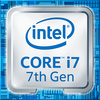Intel Core i7-7700T vs Intel Core i5-6350HQ
Intel Core i7-7700T
► remove from comparison
Der Intel Core i7-7700T ist ein High-End Quad-Core Desktop-Prozessor auf Basis der Kaby-Lake-Architektur, der Anfang 2017 vorgestellt wurde. Im Vergleich zu dem deutlich schnelleren Core i7-7700K ist der Core i7-7700T geringer getaktet aber auch deutlich sparsamer mit einem TDP von 35 Watt.
Performance
Die Performance des Intel Core i7-7700T liegt knapp oberhalb eines Core i5-7600K durch die geringere Taktung. Zur Zeit der Erscheinung ist er der schnellste 35-Watt-Desktop-Prozessor der Kaby-Lake-Serie von Intel. Auch anspruchsvollste Programme und Spiele werden von der High-End-CPU problemlos bewältigt.
Grafikeinheit
Für Grafikberechnungen zeigt sich die im Prozessor integrierte Intel HD Graphics 630 mit 24 EUs (Execution Units) verantwortlich, die mit 350 - 1150 MHz taktet. Die Leistung ist vergleichbar mit der alten Intel HD Graphics 530 und siedelt sich daher im absoluten Low-End-Bereich an, sodass aktuelle Spiele allenfalls in niedrigen Einstellungen flüssig dargestellt werden.
Intel Core i5-6350HQ
► remove from comparison
Der Intel Core i5-6350HQ ist ein schneller Quad-Core-Prozessor für Notebooks auf Basis der Skylake-Architektur, der Anfang 2016 vorgestellt wurde. Neben den vier CPU-Kernen (kein Hyper-Threading-Support), die mit 2,3 bis 3,2 GHz takten (vermutliche Turbo-Stufen: 4 Kerne: max. 2,8 GHz, 2 Kerne: max. 3,0 GHz), integriert der Prozessor auch eine Iris Pro Graphics 580 Grafikeinheit sowie einen Dual-Channel-Speichercontroller (DDR3L-1600/DDR4-2133). Die Fertigung erfolgt in einem 14-Nanometer-Prozess mit FinFET-Transistoren.
Im Unterschied zum Core i5-6300HQ verfügt der i5-6350HQ zwar über die deutlich stärkere Grafiklösung, unterstützt dafür aber die Befehlssatzerweiterung TSX-NI nicht.
Architektur
Mit Skylake löst Intel sowohl Broadwell als auch Haswell ab und setzt damit in sämtlichen TDP-Klassen von 4,5 bis 45 Watt wieder auf ein einheitliches Kerndesign. Zu den diversen Verbesserungen der Skylake-Architektur gehören unter anderem vergrößerte Out-of-Order-Buffer, Optimierungen bei Prefetching und Sprungvorhersage sowie stärkere Zugewinne durch Hyper-Threading (falls unterstützt). Insgesamt fallen die Änderungen für einen "Tock", das heißt eine neue Mikroarchitektur, jedoch eher klein aus, sodass die Pro-MHz-Leistung nur um etwa 5 bis 10 Prozent (gegenüber Haswell) respektive unter 5 Prozent (gegenüber Broadwell) ansteigt.
In einigen Fällen profitiert der Core i5-6350HQ zusätzlich von seinem 128 MB großen eDRAM, der vor allem speicherlastige Anwendungen stark beschleunigen kann.
Performance
Abhängig davon, wie stark sich der eDRAM-Cache in der jeweiligen Anwendung auswirkt, erreicht der i5-6350HQ bei Auslastung von maximal vier Threads in etwa das Performance-Niveau eines i7-4700HQ (Haswell). In noch besser parallelisierter Software fällt der Core i5 mangels Hyper-Threading-Unterstützung jedoch um bis zu 25 Prozent zurück. Dennoch werden selbst anspruchsvollste Anwendungen und exzessives Multitasking problemlos bewältigt.
Grafikeinheit
Die integrierte Grafikeinheit namens Iris Pro Graphics 580 repräsentiert die schnellste, auch als "GT4e" bezeichnete Ausbaustufe der Skylake-GPU (Intel Gen. 9). Die 72 Ausführungseinheiten (Execution Units bzw. EUs) takten in diesem Fall mit 350 bis 900 MHz und ermöglichen eine Performance auf dem Niveau dedizierter Mittelklasse-Beschleuniger. Im Optimalfall könnte die GPU knapp an eine GeForce 945M herankommen und ist damit die mit Abstand schnellste integrierte Grafiklösung auf dem Markt. Aktuelle Spiele des Jahres 2015/2016 werden in zumeist mittleren Einstellungen flüssig dargestellt. Weitere Informationen zu Performance und Features liefert unsere Detailseite zur Iris Pro Graphics 580.
Leistungsaufnahme
Entsprechend seiner TDP von 45 Watt ist der Chip vorrangig in größeren Notebooks ab etwa 15 Zoll zu finden. Optional kann die TDP auch auf 35 Watt abgesenkt werden (cTDP down), was allerdings die Performance mindert.
| Model | Intel Core i7-7700T | Intel Core i5-6350HQ | ||||||||||||||||||||||||||||||||||||||||||||||||||||||||||||||||||||||||||||||||||||||||||||||||||||||||||||||||||||||||||||||||||||||||||||||||||||||||||||||||||||||||||||||||||||||||||||||||||||||||||||||||
| Codename | Kaby Lake | Skylake | ||||||||||||||||||||||||||||||||||||||||||||||||||||||||||||||||||||||||||||||||||||||||||||||||||||||||||||||||||||||||||||||||||||||||||||||||||||||||||||||||||||||||||||||||||||||||||||||||||||||||||||||||
| Series | Intel Kaby Lake | Intel Core i5 | ||||||||||||||||||||||||||||||||||||||||||||||||||||||||||||||||||||||||||||||||||||||||||||||||||||||||||||||||||||||||||||||||||||||||||||||||||||||||||||||||||||||||||||||||||||||||||||||||||||||||||||||||
| Serie: Core i5 Skylake |
|
| ||||||||||||||||||||||||||||||||||||||||||||||||||||||||||||||||||||||||||||||||||||||||||||||||||||||||||||||||||||||||||||||||||||||||||||||||||||||||||||||||||||||||||||||||||||||||||||||||||||||||||||||||
| Clock | 2900 - 3800 MHz | 2300 - 3200 MHz | ||||||||||||||||||||||||||||||||||||||||||||||||||||||||||||||||||||||||||||||||||||||||||||||||||||||||||||||||||||||||||||||||||||||||||||||||||||||||||||||||||||||||||||||||||||||||||||||||||||||||||||||||
| L1 Cache | 256 KB | 256 KB | ||||||||||||||||||||||||||||||||||||||||||||||||||||||||||||||||||||||||||||||||||||||||||||||||||||||||||||||||||||||||||||||||||||||||||||||||||||||||||||||||||||||||||||||||||||||||||||||||||||||||||||||||
| L2 Cache | 1 MB | 1 MB | ||||||||||||||||||||||||||||||||||||||||||||||||||||||||||||||||||||||||||||||||||||||||||||||||||||||||||||||||||||||||||||||||||||||||||||||||||||||||||||||||||||||||||||||||||||||||||||||||||||||||||||||||
| L3 Cache | 8 MB | 6 MB | ||||||||||||||||||||||||||||||||||||||||||||||||||||||||||||||||||||||||||||||||||||||||||||||||||||||||||||||||||||||||||||||||||||||||||||||||||||||||||||||||||||||||||||||||||||||||||||||||||||||||||||||||
| Cores / Threads | 4 / 8 | 4 / 4 | ||||||||||||||||||||||||||||||||||||||||||||||||||||||||||||||||||||||||||||||||||||||||||||||||||||||||||||||||||||||||||||||||||||||||||||||||||||||||||||||||||||||||||||||||||||||||||||||||||||||||||||||||
| TDP | 35 Watt | 45 Watt | ||||||||||||||||||||||||||||||||||||||||||||||||||||||||||||||||||||||||||||||||||||||||||||||||||||||||||||||||||||||||||||||||||||||||||||||||||||||||||||||||||||||||||||||||||||||||||||||||||||||||||||||||
| Technology | 14 nm | 14 nm | ||||||||||||||||||||||||||||||||||||||||||||||||||||||||||||||||||||||||||||||||||||||||||||||||||||||||||||||||||||||||||||||||||||||||||||||||||||||||||||||||||||||||||||||||||||||||||||||||||||||||||||||||
| Socket | FCLGA1151 | BGA | ||||||||||||||||||||||||||||||||||||||||||||||||||||||||||||||||||||||||||||||||||||||||||||||||||||||||||||||||||||||||||||||||||||||||||||||||||||||||||||||||||||||||||||||||||||||||||||||||||||||||||||||||
| Features | DDR3(L)-1600/DDR4-2400 Memory Controller, AVX, AVX2, AES-NI, TSX-NI, Quick Sync, Virtualization, vPro | Dual-Channel DDR3L-1600/DDR4-2133 Memory Controller, AVX, AVX2, Quick Sync, Virtualization, AES-NI | ||||||||||||||||||||||||||||||||||||||||||||||||||||||||||||||||||||||||||||||||||||||||||||||||||||||||||||||||||||||||||||||||||||||||||||||||||||||||||||||||||||||||||||||||||||||||||||||||||||||||||||||||
| iGPU | Intel HD Graphics 630 (350 - 1150 MHz) | Intel Iris Pro Graphics 580 (350 - 900 MHz) | ||||||||||||||||||||||||||||||||||||||||||||||||||||||||||||||||||||||||||||||||||||||||||||||||||||||||||||||||||||||||||||||||||||||||||||||||||||||||||||||||||||||||||||||||||||||||||||||||||||||||||||||||
| Architecture | x86 | x86 | ||||||||||||||||||||||||||||||||||||||||||||||||||||||||||||||||||||||||||||||||||||||||||||||||||||||||||||||||||||||||||||||||||||||||||||||||||||||||||||||||||||||||||||||||||||||||||||||||||||||||||||||||
| $303 U.S. | $306 U.S. | |||||||||||||||||||||||||||||||||||||||||||||||||||||||||||||||||||||||||||||||||||||||||||||||||||||||||||||||||||||||||||||||||||||||||||||||||||||||||||||||||||||||||||||||||||||||||||||||||||||||||||||||||
| Announced | ||||||||||||||||||||||||||||||||||||||||||||||||||||||||||||||||||||||||||||||||||||||||||||||||||||||||||||||||||||||||||||||||||||||||||||||||||||||||||||||||||||||||||||||||||||||||||||||||||||||||||||||||||
| Manufacturer | ark.intel.com | ark.intel.com | ||||||||||||||||||||||||||||||||||||||||||||||||||||||||||||||||||||||||||||||||||||||||||||||||||||||||||||||||||||||||||||||||||||||||||||||||||||||||||||||||||||||||||||||||||||||||||||||||||||||||||||||||
| max. Temp. | 100 °C |
Benchmarks
Average Benchmarks Intel Core i7-7700T → 100% n=2
Average Benchmarks Intel Core i5-6350HQ → 95% n=2
* Smaller numbers mean a higher performance
1 This benchmark is not used for the average calculation













